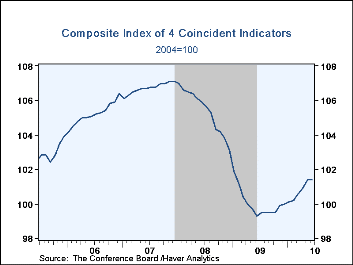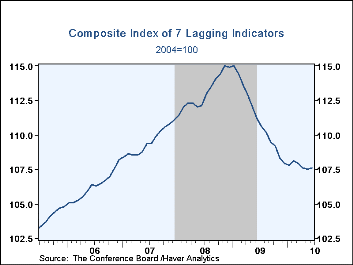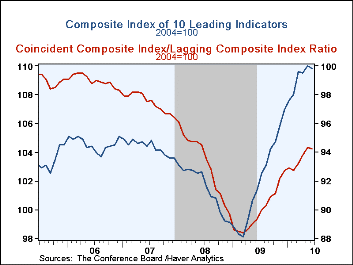 Global| Jul 22 2010
Global| Jul 22 2010U.S. Leading Economic Indicators Fall
by:Tom Moeller
|in:Economy in Brief
Summary
For the second month in the last three, the Conference Board reported that their Index of Leading Economic Indicators fell. During June, the index slipped 0.2% following a revised 0.5% May gain, initially reported at 0.4%, and a 0.1% [...]
 For the second month in the last three, the Conference Board reported that
their Index of Leading Economic Indicators fell. During June, the index slipped
0.2% following a revised 0.5% May gain, initially reported at 0.4%, and a 0.1%
April slip, earlier reported as no-change. The three-month rate of increase held
steady at 7.2% (AR), still its weakest in roughly one year. The leading index is
based on actual reports for eight economic data series. The Conference Board
initially estimates two series, consumer and capital goods orders.
For the second month in the last three, the Conference Board reported that
their Index of Leading Economic Indicators fell. During June, the index slipped
0.2% following a revised 0.5% May gain, initially reported at 0.4%, and a 0.1%
April slip, earlier reported as no-change. The three-month rate of increase held
steady at 7.2% (AR), still its weakest in roughly one year. The leading index is
based on actual reports for eight economic data series. The Conference Board
initially estimates two series, consumer and capital goods orders.
The breadth of increase amongst the component leading series improved slightly m/m to 60%, still near its lowest since March of last year. A shorter workweek, quicker vendor delivery speeds, and lower stock prices had the largest negative influences on the June indicator index. These were offset by a steeper interest rate yield curve and a firmer money supply.
The index of coincident indicators was unchanged following seven months of moderate increase. The three-month change of 3.2% was off the May high of 4.9%. Three of the four component series rose last month including real personal income, business sales and payroll employment. Payroll employment fell with the decline in the number of Census workers.
The lagging index ticked up 0.1% and has been little-changed since November. The ratio of coincident-to-lagging indicators (another leading indicator) slipped from the highest level since July, 2008.
The Conference Board figures are available in Haver's BCI database. Visit the Conference Board's site for coverage of leading indicator series from around the world. The latest U.S. Leading Indicators release can be found here.
| Business Cycle Indicators (%) | June | May | April | March 6-Month %(AR) | 2009 | 2008 | 2007 |
|---|---|---|---|---|---|---|---|
| Leading | -0.2 | 0.5 | -0.1 | 7.9 | 0.5 | -2.7 | -0.2 |
| Coincident | 0.0 | 0.5 | 0.3 | 2.8 | -5.1 | -1.2 | 1.4 |
| Lagging | 0.1 | -0.1 | -0.3 | -0.9 | -1.6 | 3.2 | 3.0 |
Tom Moeller
AuthorMore in Author Profile »Prior to joining Haver Analytics in 2000, Mr. Moeller worked as the Economist at Chancellor Capital Management from 1985 to 1999. There, he developed comprehensive economic forecasts and interpreted economic data for equity and fixed income portfolio managers. Also at Chancellor, Mr. Moeller worked as an equity analyst and was responsible for researching and rating companies in the economically sensitive automobile and housing industries for investment in Chancellor’s equity portfolio. Prior to joining Chancellor, Mr. Moeller was an Economist at Citibank from 1979 to 1984. He also analyzed pricing behavior in the metals industry for the Council on Wage and Price Stability in Washington, D.C. In 1999, Mr. Moeller received the award for most accurate forecast from the Forecasters' Club of New York. From 1990 to 1992 he was President of the New York Association for Business Economists. Mr. Moeller earned an M.B.A. in Finance from Fordham University, where he graduated in 1987. He holds a Bachelor of Arts in Economics from George Washington University.








